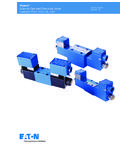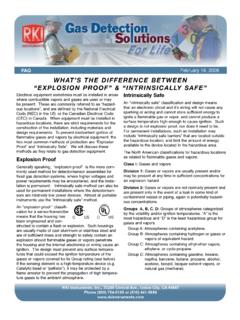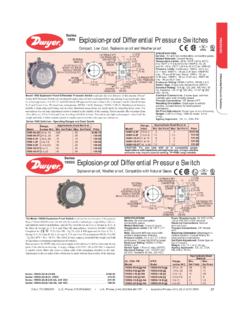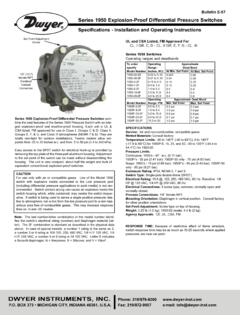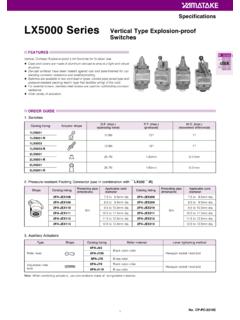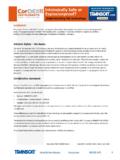Transcription of Class/Division Hazardous Location - Rockwell …
1 Class/Division Hazardous LocationClass/ division Hazardous Location2 Table of ContentsIntroduction .. 3 Basic Requirements for an explosion ..4 What is an explosion ? .. 4 When will an explosion occur? .. 4 Flammable Substance .. 5 Oxidizer .. 6 Ignition Source .. 6 Where do explosions most frequently occur? ..7 How is the explosion controlled? ..8 Principles for Ensuring that Electrical Equipment Does Not Become a Source of Ignition.. 8 Design Regulations for explosion -Proof Electrical Equipment .. 9 Definitions.. 10 Area Classification.. 10 class Definition .. 10 division Definition .. 11 Group Definition.. 11 Temperature class Definition ..12 Protection Methods .. 13A. Confine the explosion ..13B. Limit the Energy .. 15C. Isolate the Hazard .. 16 Summary of Protection Methods.
2 17 Marking ..18 Execution to NEC/CEC Standards ..18 Comparisons between the Class/Division vs. Zone System .. 19 Appendix A ..20 Comparing IEC, NEC, and CEC Zones Standardwith NEC/CEC Class/Division Standard ..20 Hazardous (Classified) locations in Accordance with Article 500, NEC - 1990 .. 23 Class/Division Hazardous Location33 IntroductionA major safety concern in industrial plants is the occurrence of fires and explosions. No other aspect of industrial safety receives more attention in the form of codes, standards, technical papers, and engineering design. Regulatory bodies like the Occupational Safety and Health Administration (OSHA) have established systems that classify locations which exhibit potentially dangerous conditions to the degree of hazard Publication 3073 defines a Hazardous Location as follows: Hazardous locations are areas where flammable liquids, gases or vapors or combustible dusts exist in sufficient quantities to produce an explosion or fire.
3 In Hazardous locations , specially designed equipment and special installation techniques must be used to protect against the explosive and flammable potential of these National Electrical Code (NEC) and the Canadian Electrical Code (CEC) defines Hazardous areas as the following:An area where a potential hazard ( , a fire, an explosion , etc.) may exist under normal or abnormal conditions because of the presence of flammable gases or vapors, combustible dusts or ignitable fibers or locations can also be described as those locations where electrical equipment might be installed and which, by their nature, might present a condition which could become explosive if the elements for ignition are present. Unfortunately, flammable substances are not always avoidable, , methane and coal dust in mines.
4 Therefore, it is of great importance that a user of electrical equipment, such as push buttons and pilot lights, be aware of the environment in which these products will be installed. The user s understanding of the hazard will help ensure that the electrical equipment is properly selected, installed and operated to provide a safe operating are a great variety of applications, especially in the chemical and petrochemical industries, that require explosion protected equipment. As a result, there have been principles and technologies developed to allow electrical instrumentation and control devices to be used even in environments where there is a danger of explosion . However, focus on explosion protected electrical equipment is not limited to utilization and processing of oil and natural gas.
5 It has expanded into new fields such as waste disposal, landfills and the utilization of Hazardous Location4 Basic Requirements for an ExplosionWhat is an explosion ?An explosion is defined as a sudden reaction involving rapid physical or chemical decay accompanied by an increase in temperature or pressure or both. When will an explosion occur?The most common types of reaction are between flammable gases, vapors, or dust with oxygen contained in the surrounding a rule, 3 basic requirements must be met for an explosion to take place in atmospheric substance needs to be present in sufficient quantity to produce an ignitable or explosive must be present in sufficient quantity in combination with the flammable substance to produce an explosive mixture. Most common is air (O2).
6 Of ignition a spark or high heat must be presence of these three elements make up the sides of the ignition triangle. If any one of the three elements is missing, an explosion will not occur. All three elements must exist simultaneously for an explosion to SourceOxidizerFlammable SubstanceExplosionClass/ division Hazardous Location55 Flammable SubstanceFlammable substances can be divided into three subgroups: Flammable gas Flammable liquids/vapors Flammable solidsTable A. Flammable SubstanceExamplesDescriptionFlammable GasHydrogen, etc. Often compounds of hydrogen and carbon that require very little to react with atmospheric Liquids/VaporsHydrocarbons such as ether, acetone, lighter fluids, etc. Even at room temperature, sufficient quantities of these hydrocarbons can evaporate to form a potentially explosive atmosphere at their surface.
7 Other liquids require higher temperature for this to occur. The flash point of a flammable liquid is the lowest temperature at which a sufficient quantity of vapor will arise to permit ignition under laboratory conditions. This is an important factor in the classification of Hazardous areas. Flammable liquids with a high flash point are less Hazardous than liquids with a low flash SolidsDust, fibers, and flyings The cumulative nature of the dust hazard is the most significant difference between a gas/vapor hazard and the dust hazard. A dust cloud will settle on nearby surfaces if it is not ignited. Unless removed, layers of dust can build up and will serve as fuel for subsequent ignition. The typical dust explosion starts with the ignition of a small dust cloud resulting in relatively small damages.
8 Pressure waves of the small initial explosion are the most damaging part of the dust pressure waves release dust layers from surrounding vertical or horizontal surfaces to produce a larger cloud which is ignited by the burning particles of the initial this way, the small initial explosion can produce a much larger explosion . In some cases a series of explosions occur, each stronger than the Hazardous Location6 Note: Every flammable gas or vapor has specific lower and upper flammability limits. If the substance or concentration in the oxidizer is either below a specific value (lower flammability limit) or above a specific value (upper flammability limit), ignition might occur; however, a flame will not a flammable gas or vapor cloud is released and ignited, all the material may be consumed in one explosion .
9 If the flammable gas or vapor cloud is not ignited, convection and diffusion will eventually disperse the flammable cloud, the immediate danger passes, and the particular fuel source is oxidizer referred to in all common Hazardous Location standards and explosion -proof equipment is air at normal atmospheric conditions. The oxygen in the air is only enough for the combustion of a certain quantity of flammable material. Air must be present in sufficient volume to propagate a flame before the air-fuel mixture becomes a hazard. When the amount of available atmospheric oxygen is more or less in equilibrium with the quantity of flammable material, the effect of an explosion both temperature and pressure is most violent. If the quantity of flammable material is too small, combustion will spread with difficulty or cease altogether.
10 The same applies if the quantity of flammable material is too great for the available flammable material has an upper and lower explosion limit above or below which no explosion will take place. This can be exploited by diluting the flammable substances with air or preventing the ingress of air/oxygen. The latter option is ruled out in environments where people work regularly and is feasible only in a chemical plant where there are no human presence of an oxygen-enriched atmosphere or a pressurized enclosure alters the conditions for ignition and dictates the use of special means for prevention and containment of explosions. No means of explosion protection considered safe for atmospheric mixtures should be used in either oxygen-enriched or pressurized situations without careful SourceThe amount of energy required to cause ignition is dependent upon these factors: The concentration of the Hazardous substance within its specific flammability limits.












